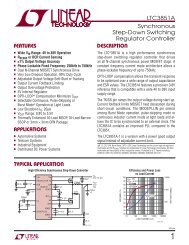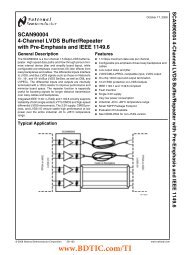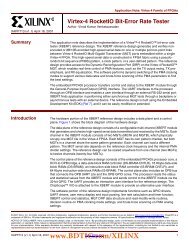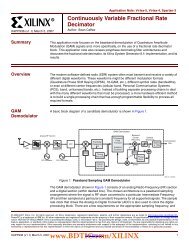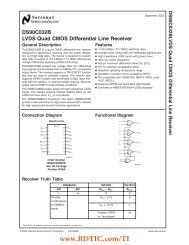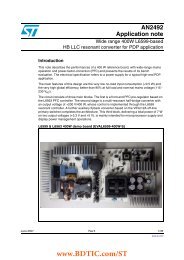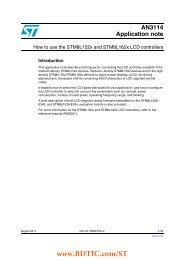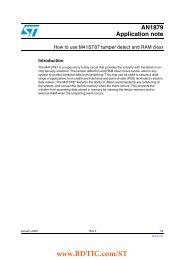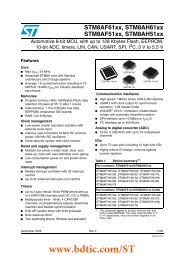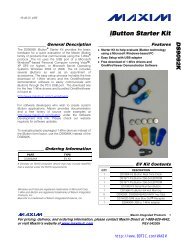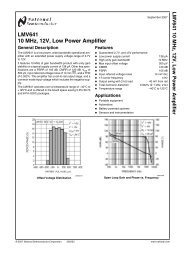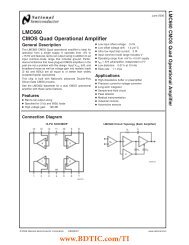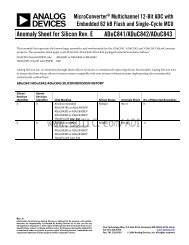LP3871/LP3874 0.8A Fast Ultra Low Dropout Linear Regulators
LP3871/LP3874 0.8A Fast Ultra Low Dropout Linear Regulators
LP3871/LP3874 0.8A Fast Ultra Low Dropout Linear Regulators
You also want an ePaper? Increase the reach of your titles
YUMPU automatically turns print PDFs into web optimized ePapers that Google loves.
<strong>LP3871</strong>/<strong>LP3874</strong><strong>0.8A</strong> <strong>Fast</strong> <strong>Ultra</strong> <strong>Low</strong> <strong>Dropout</strong> <strong>Linear</strong> <strong>Regulators</strong>General DescriptionThe <strong>LP3871</strong>/<strong>LP3874</strong> series of fast ultra low-dropout linearregulators operate from a +2.5V to +7.0V input supply. Widerange of preset output voltage options are available. Theseultra low dropout linear regulators respond very quickly tostep changes in load, which makes them suitable for lowvoltage microprocessor applications. The <strong>LP3871</strong>/<strong>LP3874</strong>are developed on a CMOS process which allows low quiescentcurrent operation independent of output load current.This CMOS process also allows the <strong>LP3871</strong>/<strong>LP3874</strong> to operateunder extremely low dropout conditions.<strong>Dropout</strong> Voltage: <strong>Ultra</strong> low dropout voltage; typically 24mVat 80mA load current and 240mV at <strong>0.8A</strong> load current.Ground Pin Current: Typically 6mA at <strong>0.8A</strong> load current.Shutdown Mode: Typically 10nA quiescent current whenthe shutdown pin is pulled low.Error Flag: Error flag goes low when the output voltagedrops 10% below nominal value.SENSE: Sense pin improves regulation at remote loads.Precision Output Voltage: Multiple output voltage optionsare available ranging from 1.8V to 5.0V with a guaranteedaccuracy of ±1.5% at room temperature, and ±3.0% over allconditions (varying line, load, and temperature).Typical Application CircuitsFeaturesn <strong>Ultra</strong> low dropout voltagen <strong>Low</strong> ground pin currentn Load regulation of 0.04%n 10nA quiescent current in shutdown moden Guaranteed output current of <strong>0.8A</strong> DCn Available in TO-263, TO-220 and SOT-223 packagesn Output voltage accuracy ± 1.5%n Error flag indicates output statusn Sense option improves load regulationn Minimum output capacitor requirementsn Overtemperature/overcurrent protectionn −40˚C to +125˚C junction temperature rangeApplicationsn Microprocessor power suppliesn GTL, GTL+, BTL, and SSTL bus terminatorsn Power supplies for DSPsn SCSI terminatorn Post regulatorsn High efficiency linear regulatorsn Battery chargersn Other battery powered applicationsSeptember 2006<strong>LP3871</strong>/<strong>LP3874</strong> <strong>0.8A</strong> <strong>Fast</strong> <strong>Ultra</strong> <strong>Low</strong> <strong>Dropout</strong> <strong>Linear</strong> <strong>Regulators</strong>20063101*SD and ERROR pins must be pulled high through a 10kΩ pull-up resistor. Connect the ERROR pin to ground if this function is not used. See application hintsfor more information.© 2006 National Semiconductor Corporation DS200631 www.national.comwww.BDTIC.com/TI
Pin Descriptions for TO220-5 and TO263-5 PackagesPin #<strong>LP3871</strong><strong>LP3874</strong>Name Function Name Function1 SD Shutdown SD Shutdown2 V IN Input Supply V IN Input Supply3 GND Ground GND Ground4 V OUT Output Voltage V OUT Output Voltage5 ERROR ERROR Flag SENSE Remote Sense Pin<strong>LP3871</strong>/<strong>LP3874</strong>Pin Descriptions for SOT223-5 PackagePin #<strong>LP3871</strong><strong>LP3874</strong>Name Function Name Function1 SD Shutdown SD Shutdown2 V IN Input Supply V IN Input Supply3 V OUT Output Voltage V OUT Output Voltage4 ERROR ERROR Flag SENSE Remote Sense Pin5 GND Ground GND Ground3www.BDTIC.com/TIwww.national.com
<strong>LP3871</strong>/<strong>LP3874</strong>Ordering InformationPackage Type Designator is "T" for TO220 package, and "S" for TO263 package, and "MP" for SOT-223 package.20063131OutputVoltageOrder NumberTABLE 1. Package Marking and Ordering InformationDescription(Current, Option)PackageTypePackageMarking5.0 <strong>LP3871</strong>ES-5.0 <strong>0.8A</strong>, Error Flag TO263-5 <strong>LP3871</strong>ES-5.0 Rail5.0 <strong>LP3871</strong>ESX-5.0 <strong>0.8A</strong>, Error Flag TO263-5 <strong>LP3871</strong>ES-5.0 Tape and Reel3.3 <strong>LP3871</strong>ES-3.3 <strong>0.8A</strong>, Error Flag TO263-5 <strong>LP3871</strong>ES-3.3 Rail3.3 <strong>LP3871</strong>ESX-3.3 <strong>0.8A</strong>, Error Flag TO263-5 <strong>LP3871</strong>ES-3.3 Tape and Reel2.5 <strong>LP3871</strong>ES-2.5 <strong>0.8A</strong>, Error Flag TO263-5 <strong>LP3871</strong>ES-2.5 Rail2.5 <strong>LP3871</strong>ESX-2.5 <strong>0.8A</strong>, Error Flag TO263-5 <strong>LP3871</strong>ES-2.5 Tape and Reel1.8 <strong>LP3871</strong>ES-1.8 <strong>0.8A</strong>, Error Flag TO263-5 <strong>LP3871</strong>ES-1.8 Rail1.8 <strong>LP3871</strong>ESX-1.8 <strong>0.8A</strong>, Error Flag TO263-5 <strong>LP3871</strong>ES-1.8 Tape and Reel5.0 <strong>LP3874</strong>ES-5.0 <strong>0.8A</strong>, SENSE TO263-5 <strong>LP3874</strong>ES-5.0 Rail5.0 <strong>LP3874</strong>ESX-5.0 <strong>0.8A</strong>, SENSE TO263-5 <strong>LP3874</strong>ES-5.0 Tape and Reel3.3 <strong>LP3874</strong>ES-3.3 <strong>0.8A</strong>, SENSE TO263-5 <strong>LP3874</strong>ES-3.3 Rail3.3 <strong>LP3874</strong>ESX-3.3 <strong>0.8A</strong>, SENSE TO263-5 <strong>LP3874</strong>ES-3.3 Tape and Reel2.5 <strong>LP3874</strong>ES-2.5 <strong>0.8A</strong>, SENSE TO263-5 <strong>LP3874</strong>ES-2.5 Rail2.5 <strong>LP3874</strong>ESX-2.5 <strong>0.8A</strong>, SENSE TO263-5 <strong>LP3874</strong>ES-2.5 Tape and Reel1.8 <strong>LP3874</strong>ES-1.8 <strong>0.8A</strong>, SENSE TO263-5 <strong>LP3874</strong>ES-1.8 Rail1.8 <strong>LP3874</strong>ESX-1.8 <strong>0.8A</strong>, SENSE TO263-5 <strong>LP3874</strong>ES-1.8 Tape and Reel5.0 <strong>LP3871</strong>ET-5.0 <strong>0.8A</strong>, Error Flag TO220-5 <strong>LP3871</strong>ET-5.0 Rail3.3 <strong>LP3871</strong>ET-3.3 <strong>0.8A</strong>, Error Flag TO220-5 <strong>LP3871</strong>ET-3.3 Rail2.5 <strong>LP3871</strong>ET-2.5 <strong>0.8A</strong>, Error Flag TO220-5 <strong>LP3871</strong>ET-2.5 Rail1.8 <strong>LP3871</strong>ET-1.8 <strong>0.8A</strong>, Error Flag TO220-5 <strong>LP3871</strong>ET-1.8 Rail5.0 <strong>LP3874</strong>ET-5.0 <strong>0.8A</strong>, SENSE TO220-5 <strong>LP3874</strong>ET-5.0 Rail3.3 <strong>LP3874</strong>ET-3.3 <strong>0.8A</strong>, SENSE TO220-5 <strong>LP3874</strong>ET-3.3 Rail2.5 <strong>LP3874</strong>ET-2.5 <strong>0.8A</strong>, SENSE TO220-5 <strong>LP3874</strong>ET-2.5 Rail1.8 <strong>LP3874</strong>ET-1.8 <strong>0.8A</strong>, SENSE TO220-5 <strong>LP3874</strong>ET-1.8 RailSupplied As:5.0 <strong>LP3871</strong>EMP-5.0 <strong>0.8A</strong>, Error Flag SOT223-5 LH9B 1000 Units on Tape and Reel5.0 <strong>LP3871</strong>EMPX-5.0 <strong>0.8A</strong>, Error Flag SOT223-5 LH9B 2000 Units on Tape and Reel3.3 <strong>LP3871</strong>EMP-3.3 <strong>0.8A</strong>, Error Flag SOT223-5 LH8B 1000 Units on Tape and Reel3.3 <strong>LP3871</strong>EMPX-3.3 <strong>0.8A</strong>, Error Flag SOT223-5 LH8B 2000 Units on Tape and Reel2.5 <strong>LP3871</strong>EMP-2.5 <strong>0.8A</strong>, Error Flag SOT223-5 LH7B 1000 Units on Tape and Reel2.5 <strong>LP3871</strong>EMPX-2.5 <strong>0.8A</strong>, Error Flag SOT223-5 LH7B 2000 Units on Tape and Reel1.8 <strong>LP3871</strong>EMP-1.8 <strong>0.8A</strong>, Error Flag SOT223-5 LH6B 1000 Units on Tape and Reel1.8 <strong>LP3871</strong>EMPX-1.8 <strong>0.8A</strong>, Error Flag SOT223-5 LH6B 2000 Units on Tape and Reelwww.national.com 4www.BDTIC.com/TI
Ordering Information (Continued)OutputVoltageOrder NumberTABLE 1. Package Marking and Ordering Information (Continued)Description(Current, Option)PackageTypePackageMarkingSupplied As:5.0 <strong>LP3874</strong>EMP-5.0 <strong>0.8A</strong>, SENSE SOT223-5 LHJB 1000 Units on Tape and Reel5.0 <strong>LP3874</strong>EMPX-5.0 <strong>0.8A</strong>, SENSE SOT223-5 LHJB 2000 Units on Tape and Reel3.3 <strong>LP3874</strong>EMP-3.3 <strong>0.8A</strong>, SENSE SOT223-5 LHHB 1000 Units on Tape and Reel3.3 <strong>LP3874</strong>EMPX-3.3 <strong>0.8A</strong>, SENSE SOT223-5 LHHB 2000 Units on Tape and Reel2.5 <strong>LP3874</strong>EMP-2.5 <strong>0.8A</strong>, SENSE SOT223-5 LHFB 1000 Units on Tape and Reel2.5 <strong>LP3874</strong>EMPX-2.5 <strong>0.8A</strong>, SENSE SOT223-5 LHFB 2000 Units on Tape and Reel1.8 <strong>LP3874</strong>EMP-1.8 <strong>0.8A</strong>, SENSE SOT223-5 LHEB 1000 Units on Tape and Reel1.8 <strong>LP3874</strong>EMPX-1.8 <strong>0.8A</strong>, SENSE SOT223-5 LHEB 2000 Units on Tape and Reel<strong>LP3871</strong>/<strong>LP3874</strong>5www.BDTIC.com/TIwww.national.com
<strong>LP3871</strong>/<strong>LP3874</strong>Block Diagrams<strong>LP3871</strong>20063103<strong>LP3874</strong>20063129www.national.com 6www.BDTIC.com/TI
Absolute Maximum Ratings (Note 1)If Military/Aerospace specified devices are required, please contact the National Semiconductor Sales Office/Distributors for availability and specifications.Storage Temperature Range−65˚C to +150˚CLead Temperature(Soldering, 5 sec.)260˚CESD Rating (Note 3)2 kVPower Dissipation (Note 2)Internally LimitedInput Supply Voltage (Survival)−0.3V to +7.5VShutdown Input Voltage(Survival) −0.3V to 7.5VOutput Voltage (Survival), (Note6), (Note 7) −0.3V to +6.0VI OUT (Survival)Short Circuit ProtectedMaximum Voltage for ERRORPinMaximum Voltage for SENSE PinOperating RatingsV INV OUTInput Supply Voltage (Note 11) 2.5V to 7.0VShutdown Input Voltage −0.3V to 7.0VMaximum Operating Current (DC) <strong>0.8A</strong>Junction Temperature−40˚C to +125˚C<strong>LP3871</strong>/<strong>LP3874</strong>Electrical Characteristics<strong>LP3871</strong>/<strong>LP3874</strong>Limits in standard typeface are for T J = 25˚C, and limits in boldface type apply over the full operating temperature range.Unless otherwise specified: V IN =V O(NOM) + 1V, I L = 10 mA, C OUT = 10µF, V SD = 2V.Symbol Parameter Conditions Typ <strong>LP3871</strong>/4 (Note 5) Units(Note 4) Min MaxV O∆V OL∆V O / ∆I OUTV IN -V OUTI GNDI GNDOutput VoltageTolerance(Note 8)Output Voltage LineRegulation (Note 8)Output Voltage LoadRegulation(Note 8)<strong>Dropout</strong> Voltage(Note 10)Ground Pin Current InNormal Operation ModeGround Pin Current InShutdown ModeV OUT +1V ≤ V IN ≤ 7.0V10 mA ≤ I L ≤ <strong>0.8A</strong> 0V OUT +1V≤ V IN ≤ 7.0V 0.020.0610 mA ≤ I L ≤ <strong>0.8A</strong> 0.040.1-1.5-3.0+1.5+3.0I L =80mA 24 3540I L = <strong>0.8A</strong> 240 300mV350I L =80mA 5 910I L = <strong>0.8A</strong> 6 14mA15V SD ≤ 0.3V 0.01 10 µA-40˚C ≤ T J ≤ 85˚C 50I O(PK) Peak Output Current V O ≥ V O(NOM) -4% 1 AShort Circuit ProtectionI SC Short Circuit Current 2.3 A%%%7www.BDTIC.com/TIwww.national.com
<strong>LP3871</strong>/<strong>LP3874</strong>Electrical Characteristics<strong>LP3871</strong>/<strong>LP3874</strong> (Continued)Limits in standard typeface are for T J = 25˚C, and limits in boldface type apply over the full operating temperature range.Unless otherwise specified: V IN =V O(NOM) + 1V, I L = 10 mA, C OUT = 10µF, V SD = 2V.Symbol Parameter Conditions Typ <strong>LP3871</strong>/4 (Note 5) Units(Note 4) Min MaxShutdown InputV SDT Shutdown ThresholdOutput = High V IN 2Output = <strong>Low</strong> 0 0.3VT dOFF Turn-off delay I L = <strong>0.8A</strong> 20 µsT dON Turn-on delay I L = <strong>0.8A</strong> 25 µsI SD SD Input Current V SD =V IN 1 nAError FlagV T Threshold (Note 9) 10 5 16 %V TH Threshold Hysteresis (Note 9) 5 2 8 %V EF(Sat) Error Flag Saturation I sink = 100µA 0.02 0.1 VTd Flag Reset Delay 1 µsI lk Error Flag Pin Leakage1 nACurrentI max Error Flag Pin Sink V Error = 0.5V 1 mACurrentAC ParametersV IN =V OUT +1VC OUT = 10uF73PSRR Ripple RejectionV OUT = 3.3V, f = 120HzV IN =V OUT + 0.5V57dBC OUT = 10uFV OUT = 3.3V, f = 120Hzρ n(l/f) Output Noise Density f = 120Hz 0.8 µVBW = 10Hz – 100kHz150e n Output Noise VoltageV OUT = 2.5VBW = 300Hz – 300kHz 100V OUT = 2.5VµV (rms)Note 1: Absolute maximum ratings indicate limits beyond which damage to the device may occur. Operating ratings indicate conditions for which the device isintended to be functional, but does not guarantee specific performance limits. For guaranteed specifications and test conditions, see Electrical Characteristics. Theguaranteed specifications apply only for the test conditions listed. Some performance characteristics may degrade when the device is not operated under the listedtest conditions.Note 2: At elevated temperatures, devices must be derated based on package thermal resistance. The devices in TO220 package must be derated at θ jA = 50˚C/W(with 0.5in 2 , 1oz. copper area), junction-to-ambient (with no heat sink). The devices in the TO263 surface-mount package must be derated at θ jA = 60˚C/W (with0.5in 2 , 1oz. copper area), junction-to-ambient. The SOT-223 package must be derated at θ jA = 90˚C/W (with 0.5in 2 , 1oz. copper area), junction-to-ambientNote 3: The human body model is a 100pF capacitor discharged through a 1.5kΩ resistor into each pin.Note 4: Typical numbers are at 25˚C and represent the most likely parametric norm.Note 5: Limits are guaranteed by testing, design, or statistical correlation.Note 6: If used in a dual-supply system where the regulator load is returned to a negative supply, the output must be diode-clamped to ground.Note 7: The output PMOS structure contains a diode between the V IN and V OUT terminals. This diode is normally reverse biased. This diode will get forward biasedif the voltage at the output terminal is forced to be higher than the voltage at the input terminal. This diode can typically withstand 200mA of DC current and 1Ampof peak current.Note 8: Output voltage line regulation is defined as the change in output voltage from the nominal value due to change in the input line voltage. Output voltage loadregulation is defined as the change in output voltage from the nominal value due to change in load current. The line and load regulation specification contains onlythe typical number. However, the limits for line and load regulation are included in the output voltage tolerance specification.Note 9: Error Flag threshold and hysteresis are specified as percentage of regulated output voltage. See Application Hints.Note 10: <strong>Dropout</strong> voltage is defined as the minimum input to output differential voltage at which the output drops 2% below the nominal value. <strong>Dropout</strong> voltagespecification applies only to output voltages of 2.5V and above. For output voltages below 2.5V, the drop-out voltage is nothing but the input to output differential,since the minimum input voltage is 2.5V.Note 11: The minimum operating value for V IN is equal to either [V OUT(NOM) +V DROPOUT ] or 2.5V, whichever is greater.www.national.com 8www.BDTIC.com/TI
Typical Performance Characteristics Unless ohterwise specified: T J = 25˚C, C OUT = 10µF,C IN = 10µF, S/D pin is tied to V IN ,V OUT = 2.5V, V IN =V O(NOM) + 1V, I L =10mA<strong>Dropout</strong> Voltage vs Output Load CurrentGround Current vs Output VoltageI L = 800mA<strong>LP3871</strong>/<strong>LP3874</strong>2006316020063154Shutdown I Q vs Junction TemperatureErrorflag Threshold vs Junction Temperature20063155 20063157DC Load Reg. vs Junction TemperatureDC Line Regulation vs Temperature20063158 200631599www.BDTIC.com/TIwww.national.com
<strong>LP3871</strong>/<strong>LP3874</strong>Typical Performance Characteristics Unless ohterwise specified: T J = 25˚C, C OUT = 10µF,C IN = 10µF, S/D pin is tied to V IN ,V OUT = 2.5V, V IN =V O(NOM) + 1V, I L = 10 mA (Continued)Noise vs FrequencyLoad Transient ResponseC IN =C OUT = 10µF, OSCON2006318120063161Load Transient ResponseC IN =C OUT = 100µF, OSCONLoad Transient ResponseC IN =C OUT = 100µF, POSCAP20063182 20063183Load Transient ResponseC IN =C OUT = 10µF, TANTALUMLoad Transient ResponseC IN =C OUT = 100µF, TANTALUM20063184 20063185www.national.com 10www.BDTIC.com/TI
Application HintsEXTERNAL CAPACITORSLike any low-dropout regulator, external capacitors are requiredto assure stability. These capacitors must be correctlyselected for proper performance.INPUT CAPACITOR: An input capacitor of at least 10µF isrequired. Ceramic, Tantalum, or Electrolytic capacitors maybe used, and capacitance may be increased without limit.OUTPUT CAPACITOR: An output capacitor is required forloop stability. It must be located less than 1 cm from thedevice and connected directly to the output and ground pinsusing traces which have no other currents flowing throughthem (see PCB Layout section).The minimum value of output capacitance that can be usedfor stable full-load operation is 10µF, but it may be increasedwithout limit. The output capacitor must have an ESR valueas shown in the stable region of the curve (below).Tantalumcapacitors are recommended for the output capacitor.ESR Curve20063170SELECTING A CAPACITORIt is important to note that capacitance tolerance and variationwith temperature must be taken into consideration whenselecting a capacitor so that the minimum required amountof capacitance is provided over the full operating temperaturerange. In general, a good Tantalum capacitor will showvery little capacitance variation with temperature, but a ceramicmay not be as good (depending on dielectric type).Aluminum electrolytics also typically have large temperaturevariation of capacitance value.Equally important to consider is a capacitor’s ESR changewith temperature: this is not an issue with ceramics, as theirESR is extremely low. However, it is very important in Tantalumand aluminum electrolytic capacitors. Both show increasingESR at colder temperatures, but the increase inaluminum electrolytic capacitors is so severe they may notbe feasible for some applications (see Capacitor CharacteristicsSection).CAPACITOR CHARACTERISTICSCERAMIC: For values of capacitance in the 10 to 100 µFrange, ceramics are usually larger and more costly thantantalums but give superior AC performance for bypassinghigh frequency noise because of very low ESR (typically lessthan 10 mΩ). However, some dielectric types do not havegood capacitance characteristics as a function of voltageand temperature.Z5U and Y5V dielectric ceramics have capacitance thatdrops severely with applied voltage. A typical Z5U or Y5Vcapacitor can lose 60% of its rated capacitance with half ofthe rated voltage applied to it. The Z5U and Y5V also exhibita severe temperature effect, losing more than 50% of nominalcapacitance at high and low limits of the temperaturerange.X7R and X5R dielectric ceramic capacitors are strongly recommendedif ceramics are used, as they typically maintain acapacitance range within ±20% of nominal over full operatingratings of temperature and voltage. Of course, they aretypically larger and more costly than Z5U/Y5U types for agiven voltage and capacitance.TANTALUM: Solid Tantalum capacitors are recommendedfor use on the output because their typical ESR is very closeto the ideal value required for loop compensation. They alsowork well as input capacitors if selected to meet the ESRrequirements previously listed.Tantalums also have good temperature stability: a goodquality Tantalum will typically show a capacitance value thatvaries less than 10-15% across the full temperature range of125˚C to −40˚C. ESR will vary only about 2X going from thehigh to low temperature limits.The increasing ESR at lower temperatures can cause oscillationswhen marginal quality capacitors are used (if the ESRof the capacitor is near the upper limit of the stability range atroom temperature).ALUMINUM: This capacitor type offers the most capacitancefor the money. The disadvantages are that they arelarger in physical size, not widely available in surface mount,and have poor AC performance (especially at higher frequencies)due to higher ESR and ESL.Compared by size, the ESR of an aluminum electrolytic ishigher than either Tantalum or ceramic, and it also variesgreatly with temperature. A typical aluminum electrolytic canexhibit an ESR increase of as much as 50X when going from25˚C down to −40˚C.It should also be noted that many aluminum electrolytics onlyspecify impedance at a frequency of 120 Hz, which indicatesthey have poor high frequency performance. Only aluminumelectrolytics that have an impedance specified at a higherfrequency (between 20 kHz and 100 kHz) should be used forthe LP387X. Derating must be applied to the manufacturer’sESR specification, since it is typically only valid at roomtemperature.Any applications using aluminum electrolytics should bethoroughly tested at the lowest ambient operating temperaturewhere ESR is maximum.TURN-ON CHARACTERISTICS FOR OUTPUTVOLTAGES PROGRAMMED TO 2.0V OR BELOWAs Vin increases during start-up, the regulator output willtrack the input until Vin reaches the minimum operatingvoltage (typically about 2.2V). For output voltages programmedto 2.0V or below, the regulator output may momentarilyexceed its programmed output voltage during startup. Outputs programmed to voltages above 2.0V are notaffected by this behavior.PCB LAYOUTGood PC layout practices must be used or instability can beinduced because of ground loops and voltage drops. Theinput and output capacitors must be directly connected to the<strong>LP3871</strong>/<strong>LP3874</strong>11www.BDTIC.com/TIwww.national.com
<strong>LP3871</strong>/<strong>LP3874</strong>Application Hints (Continued)input, output, and ground pins of the regulator using traceswhich do not have other currents flowing in them (Kelvinconnect).The best way to do this is to lay out C IN and C OUT near thedevice with short traces to the V IN ,V OUT , and ground pins.The regulator ground pin should be connected to the externalcircuit ground so that the regulator and its capacitorshave a "single point ground".It should be noted that stability problems have been seen inapplications where "vias" to an internal ground plane wereused at the ground points of the IC and the input and outputcapacitors. This was caused by varying ground potentials atthese nodes resulting from current flowing through theground plane. Using a single point ground technique for theregulator and it’s capacitors fixed the problem.Since high current flows through the traces going into V INand coming from V OUT , Kelvin connect the capacitor leads tothese pins so there is no voltage drop in series with the inputand output capacitors.RFI/EMI SUSCEPTIBILITYRFI (radio frequency interference) and EMI (electromagneticinterference) can degrade any integrated circuit’s performancebecause of the small dimensions of the geometriesinside the device. In applications where circuit sources arepresent which generate signals with significant high frequencyenergy content (> 1 MHz), care must be taken toensure that this does not affect the IC regulator.If RFI/EMI noise is present on the input side of the regulator(such as applications where the input source comes from theoutput of a switching regulator), good ceramic bypass capacitorsmust be used at the input pin of the IC.If a load is connected to the IC output which switches at highspeed (such as a clock), the high-frequency current pulsesrequired by the load must be supplied by the capacitors onthe IC output. Since the bandwidth of the regulator loop isless than 100 kHz, the control circuitry cannot respond toload changes above that frequency. This means the effectiveoutput impedance of the IC at frequencies above 100 kHz isdetermined only by the output capacitor(s).In applications where the load is switching at high speed, theoutput of the IC may need RF isolation from the load. It isrecommended that some inductance be placed between theoutput capacitor and the load, and good RF bypass capacitorsbe placed directly across the load.PCB layout is also critical in high noise environments, sinceRFI/EMI is easily radiated directly into PC traces. Noisycircuitry should be isolated from "clean" circuits where possible,and grounded through a separate path. At MHz frequencies,ground planes begin to look inductive and RFI/EMI can cause ground bounce across the ground plane.In multi-layer PCB applications, care should be taken inlayout so that noisy power and ground planes do not radiatedirectly into adjacent layers which carry analog power andground.OUTPUT NOISENoise is specified in two ways-Spot Noise or Output noise density is the RMS sum of allnoise sources, measured at the regulator output, at a specificfrequency (measured with a 1Hz bandwidth). This typeof noise is usually plotted on a curve as a function of frequency.Total output Noise or Broad-band noise is the RMS sumof spot noise over a specified bandwidth, usually severaldecades of frequencies.Attention should be paid to the units of measurement. Spotnoise is measured in units µV/√Hz or nV/√Hz and total outputnoise is measured in µV(rms).The primary source of noise in low-dropout regulators is theinternal reference. In CMOS regulators, noise has a lowfrequency component and a high frequency component,which depend strongly on the silicon area and quiescentcurrent. Noise can be reduced in two ways: by increasing thetransistor area or by increasing the current drawn by theinternal reference. Increasing the area will decrease thechance of fitting the die into a smaller package. Increasingthe current drawn by the internal reference increases thetotal supply current (ground pin current). Using an optimizedtrade-off of ground pin current and die size, <strong>LP3871</strong>/<strong>LP3874</strong>achieves low noise performance and low quiescent currentoperation.The total output noise specification for <strong>LP3871</strong>/<strong>LP3874</strong> ispresented in the Electrical Characteristics table. The Outputnoise density at different frequencies is represented by acurve under typical performance characteristics.SHORT-CIRCUIT PROTECTIONThe <strong>LP3871</strong> and <strong>LP3874</strong> are short circuit protected and inthe event of a peak over-current condition, the short-circuitcontrol loop will rapidly drive the output PMOS pass elementoff. Once the power pass element shuts down, the controlloop will rapidly cycle the output on and off until the averagepower dissipation causes the thermal shutdown circuit torespond to servo the on/off cycling to a lower frequency.Please refer to the section on thermal information for powerdissipation calculations.ERROR FLAG OPERATIONThe <strong>LP3871</strong>/<strong>LP3874</strong> produces a logic low signal at the ErrorFlag pin when the output drops out of regulation due to lowinput voltage, current limiting, or thermal limiting. This flaghas a built in hysteresis. The timing diagram in Figure 1shows the relationship between the ERROR flag and theoutput voltage. In this example, the input voltage is changedto demonstrate the functionality of the Error Flag.The internal Error flag comparator has an open drain outputstage. Hence, the ERROR pin should be pulled high througha pull up resistor. Although the ERROR flag pin can sinkcurrent of 1mA, this current is energy drain from the inputsupply. Hence, the value of the pull up resistor should be inthe range of 10kΩ to 1MΩ. The ERROR pin must beconnected to ground if this function is not used. It shouldalso be noted that when the shutdown pin is pulled low, theERROR pin is forced to be invalid for reasons of savingpower in shutdown mode.www.national.com 12www.BDTIC.com/TI
Application Hints (Continued)<strong>LP3871</strong>/<strong>LP3874</strong>20063107FIGURE 1. Error Flag OperationSENSE PINIn applications where the regulator output is not very close tothe load, <strong>LP3874</strong> can provide better remote load regulationusing the SENSE pin. Figure 2 depicts the advantage of theSENSE option. <strong>LP3871</strong> regulates the voltage at the outputpin. Hence, the voltage at the remote load will be the regulatoroutput voltage minus the drop across the trace resistance.For example, in the case of a 3.3V output, if the traceresistance is 100mΩ, the voltage at the remote load will be3.22V with <strong>0.8A</strong> of load current, I LOAD . The <strong>LP3874</strong> regulatesthe voltage at the sense pin. Connecting the sense pin to theremote load will provide regulation at the remote load, asshown in Figure 2. If the sense option pin is not required, thesense pin must be connected to the V OUT pin.20063108FIGURE 2. Improving remote load regulation using <strong>LP3874</strong>SHUTDOWN OPERATIONA CMOS Logic level signal at the shutdown ( SD) pin willturn-off the regulator. Pin SD must be actively terminatedthrough a 10kΩ pull-up resistor for a proper operation. If thispin is driven from a source that actively pulls high and low(such as a CMOS rail to rail comparator), the pull-up resistoris not required. This pin must be tied to Vin if not used.13www.BDTIC.com/TIwww.national.com
<strong>LP3871</strong>/<strong>LP3874</strong>Application Hints (Continued)DROPOUT VOLTAGEThe dropout voltage of a regulator is defined as the minimuminput-to-output differential required to stay within 2% of thenominal output voltage. For CMOS LDOs, the dropout voltageis the product of the load current and the Rds(on) of theinternal MOSFET.REVERSE CURRENT PATHThe internal MOSFET in <strong>LP3871</strong> and <strong>LP3874</strong> has an inherentparasitic diode. During normal operation, the input voltageis higher than the output voltage and the parasitic diodeis reverse biased. However, if the output is pulled above theinput in an application, then current flows from the output tothe input as the parasitic diode gets forward biased. Theoutput can be pulled above the input as long as the currentin the parasitic diode is limited to 200mA continuous and 1Apeak.POWER DISSIPATION/HEATSINKING<strong>LP3871</strong> and <strong>LP3874</strong> can deliver a continuous current of<strong>0.8A</strong> over the full operating temperature range. A heatsinkmay be required depending on the maximum power dissipationand maximum ambient temperature of the application.Under all possible conditions, the junction temperature mustbe within the range specified under operating conditions.The total power dissipation of the device is given by:P D =(V IN −V OUT )I OUT +(V IN )I GNDwhere I GND is the operating ground current of the device(specified under Electrical Characteristics).The maximum allowable temperature rise (T Rmax ) dependson the maximum ambient temperature (T Amax ) of the application,and the maximum allowable junction temperature(T Jmax ):T Rmax =T Jmax −T AmaxThe maximum allowable value for junction to ambient ThermalResistance, θ JA , can be calculated using the formula:θ JA =T Rmax /P D<strong>LP3871</strong> and <strong>LP3874</strong> are available in TO-220 and TO-263packages. The thermal resistance depends on amount ofcopper area or heat sink, and on air flow. If the maximumallowable value of θ JA calculated above is ≥ 60 ˚C/W forTO-220 package and ≥ 60 ˚C/W for TO-263 package noheatsink is needed since the package can dissipate enoughheat to satisfy these requirements. If the value for allowableθ JA falls below these limits, a heat sink is required.HEATSINKING TO-220 PACKAGEThe thermal resistance of a TO220 package can be reducedby attaching it to a heat sink or a copper plane on a PCboard. If a copper plane is to be used, the values of θ JA willbe same as shown in next section for TO263 package.The heatsink to be used in the application should have aheatsink to ambient thermal resistance,θ HA ≤θ JA − θ CH − θ JC .In this equation, θ CH is the thermal resistance from the caseto the surface of the heat sink and θ JC is the thermal resistancefrom the junction to the surface of the case. θ JC isabout 3˚C/W for a TO220 package. The value for θ CH dependson method of attachment, insulator, etc. θ CH variesbetween 1.5˚C/W to 2.5˚C/W. If the exact value is unknown,2˚C/W can be assumed.HEATSINKING TO-263 PACKAGEThe TO-263 package uses the copper plane on the PCB asa heatsink. The tab of these packages are soldered to thecopper plane for heat sinking. Figure 3 shows a curve for theθ JA of TO-263 package for different copper area sizes, usinga typical PCB with 1 ounce copper and no solder mask overthe copper area for heat sinking.20063132FIGURE 3. θ JA vs Copper (1 Ounce) Area for TO-263packageAs shown in the figure, increasing the copper area beyond 1square inch produces very little improvement. The minimumvalue for θ JA for the TO-263 package mounted to a PCB is32˚C/W.Figure 4 shows the maximum allowable power dissipationfor TO-263 packages for different ambient temperatures,assuming θ JA is 35˚C/W and the maximum junction temperatureis 125˚C.20063133FIGURE 4. Maximum power dissipation vs ambienttemperature for TO-263 packageHEATSINKING SOT223-5 PACKAGEFigure 5 shows a curve for the θ JA of SOT-223 package fordifferent copper area sizes, using a typical PCB with 1 ouncecopper and no solder mask over the copper area for heatsinking.www.national.com 14www.BDTIC.com/TI
Application Hints (Continued)<strong>LP3871</strong>/<strong>LP3874</strong>20063192FIGURE 6. SCENARIO A, θ JA = 148˚C/W20063191FIGURE 5. θ JA vs Copper(1 Ounce) Area for SOT-223packageThe following figures show different layout scenarios forSOT-223 package.20063193FIGURE 7. SCENARIO B, θ JA = 125˚C/W15www.BDTIC.com/TIwww.national.com
<strong>LP3871</strong>/<strong>LP3874</strong>Physical Dimensions inches (millimeters) unless otherwise notedTO220 5-lead, Molded, Stagger Bend Package (TO220-5)NS Package Number T05DFor Order Numbers, refer to the “Ordering Information” section of this document.www.national.com 16www.BDTIC.com/TI
Physical Dimensions inches (millimeters) unless otherwise noted (Continued)<strong>LP3871</strong>/<strong>LP3874</strong>TO263 5-Lead, Molded, Surface Mount Package (TO263-5)NS Package Number TS5BFor Order Numbers, refer to the “Ordering Information” section of this document.17www.BDTIC.com/TIwww.national.com
<strong>LP3871</strong>/<strong>LP3874</strong> <strong>0.8A</strong> <strong>Fast</strong> <strong>Ultra</strong> <strong>Low</strong> <strong>Dropout</strong> <strong>Linear</strong> <strong>Regulators</strong>Physical Dimensions inches (millimeters) unless otherwise noted (Continued)SOT223, 5-Lead, Molded, Surface Mount Package (SOT223-5)NS Package Number MP05AFor Order Numbers, refer to the “Ordering Information” section of this document.National does not assume any responsibility for use of any circuitry described, no circuit patent licenses are implied and National reservesthe right at any time without notice to change said circuitry and specifications.For the most current product information visit us at www.national.com.LIFE SUPPORT POLICYNATIONAL’S PRODUCTS ARE NOT AUTHORIZED FOR USE AS CRITICAL COMPONENTS IN LIFE SUPPORT DEVICES OR SYSTEMSWITHOUT THE EXPRESS WRITTEN APPROVAL OF THE PRESIDENT AND GENERAL COUNSEL OF NATIONAL SEMICONDUCTORCORPORATION. As used herein:1. Life support devices or systems are devices or systemswhich, (a) are intended for surgical implant into the body, or(b) support or sustain life, and whose failure to perform whenproperly used in accordance with instructions for useprovided in the labeling, can be reasonably expected to resultin a significant injury to the user.2. A critical component is any component of a life supportdevice or system whose failure to perform can be reasonablyexpected to cause the failure of the life support device orsystem, or to affect its safety or effectiveness.BANNED SUBSTANCE COMPLIANCENational Semiconductor follows the provisions of the Product Stewardship Guide for Customers (CSP-9-111C2) and Banned Substancesand Materials of Interest Specification (CSP-9-111S2) for regulatory environmental compliance. Details may be found at:www.national.com/quality/green.Lead free products are RoHS compliant.National SemiconductorAmericas CustomerSupport CenterEmail: new.feedback@nsc.comTel: 1-800-272-9959www.national.comNational SemiconductorEurope Customer Support CenterFax: +49 (0) 180-530 85 86Email: europe.support@nsc.comDeutsch Tel: +49 (0) 69 9508 6208English Tel: +44 (0) 870 24 0 2171Français Tel: +33 (0) 1 41 91 8790National SemiconductorAsia Pacific CustomerSupport CenterEmail: ap.support@nsc.comNational SemiconductorJapan Customer Support CenterFax: 81-3-5639-7507Email: jpn.feedback@nsc.comTel: 81-3-5639-7560www.BDTIC.com/TI



